1994 CHEVROLET CAVALIER belt
[x] Cancel search: beltPage 39 of 243
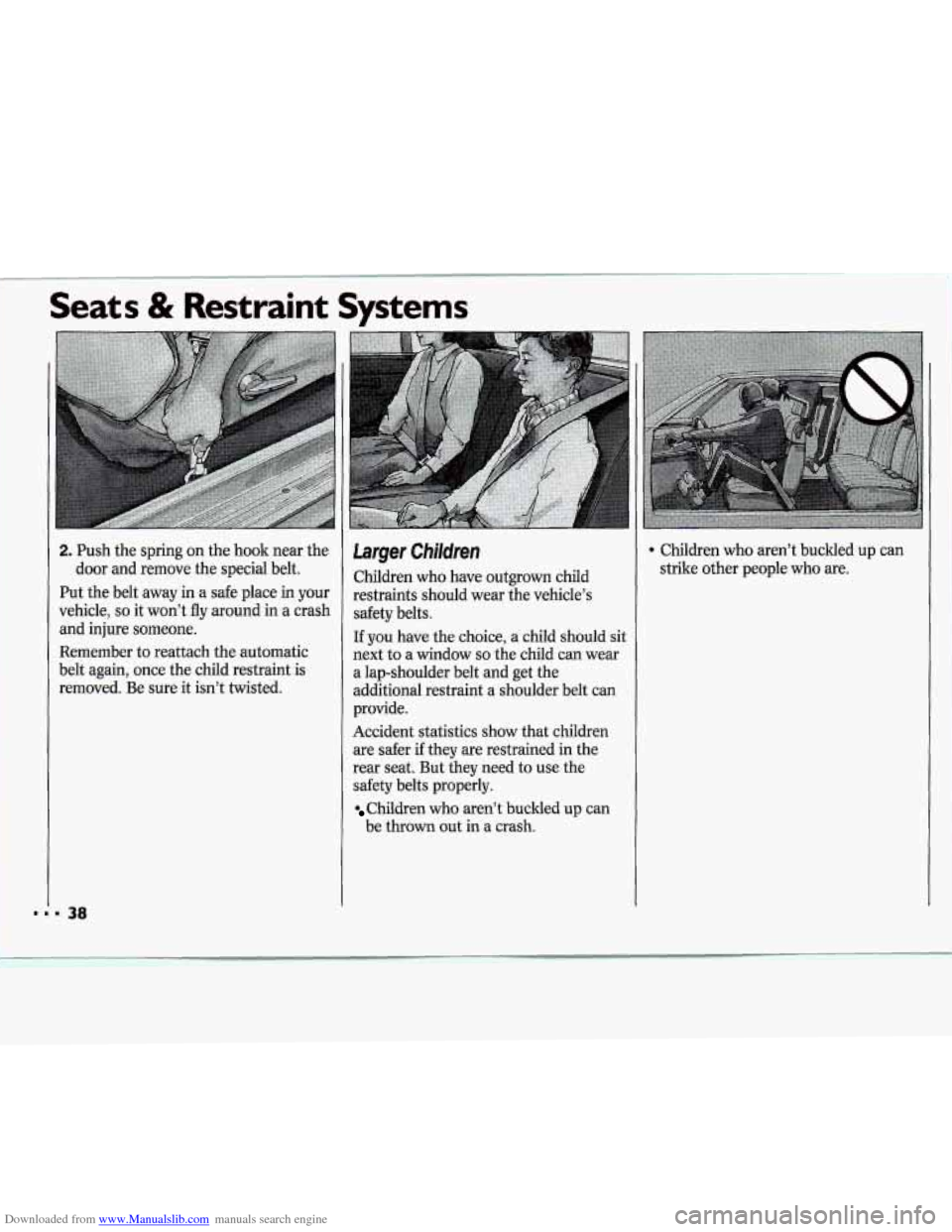
Downloaded from www.Manualslib.com manuals search engine 2. Push the spring on the hook near the
door
and remove the special belt.
Put the belt away
in a safe place in your
vehicle,
so it won’t fly around in a crash
and injure someone.
Remember
to reattach the automatic
belt again, once the child restraint is
removed. Be sure it isn’t twisted.
Larger Children
Children who have outgrown child
restraints should wear the vehicle’s
safety belts.
If you have the choice, a child should si1
next
to a window so the child can wear
a lap-shodder belt
and get the
additional restraint
a shoulder belt can
provide.
Accident statistics
show that children
are safer
if they are restrained in the
rem seat. But they
need to use the
safety belts properly.
Children who aren’t buckled up can
be
thrown out in a crash. children
who aren’t buckled
up can
strike other people
who are. I
Page 40 of 243
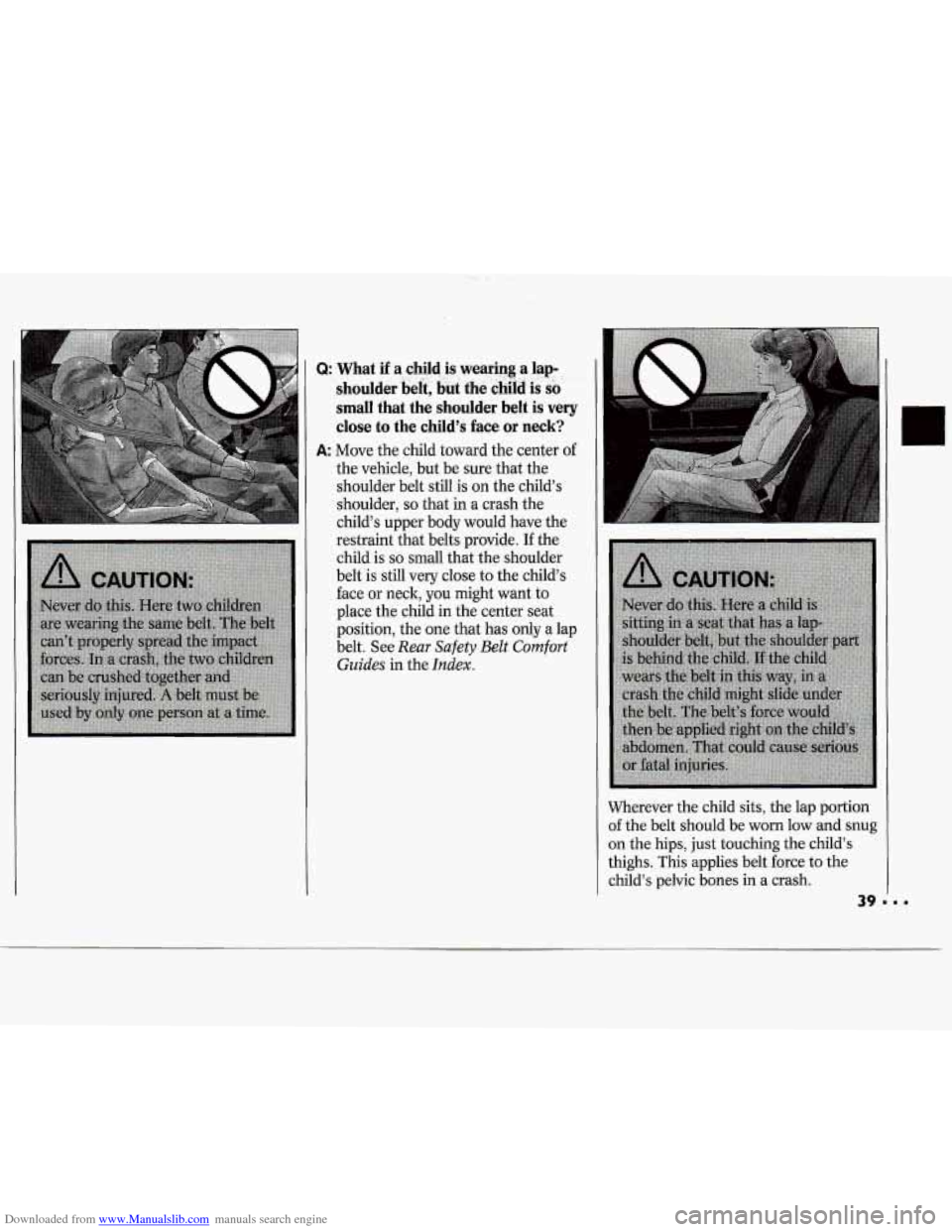
Downloaded from www.Manualslib.com manuals search engine Q: What if ,ab child .$, . . :. ..: is wearing a lap- ’ shouldet belt, tjdi the is s& I -,
small that the shoulder belt is very
close to the child’s face or neck?
A: Move the child toward the center of
the vehicle, but be sure that the
shoulder belt still is on the child’s
shoulder,
so that in a crash the
child’s upper body would have the
restraint that belts provide. If the
child is
so small that the shoulder
belt is still very close to the child’s
face or neck,
you might want to
place the child in the center seat
position, the one that has only a lap
belt. See
Rear Safety Belt Comfort
Guides
in the Index.
Wherever the child sits, the lap portion
of the belt should be worn low and snug
on the hips, just touching the child’s
thighs.
This applies belt force to the
child’s pelvic bones in
a crash.
Page 41 of 243
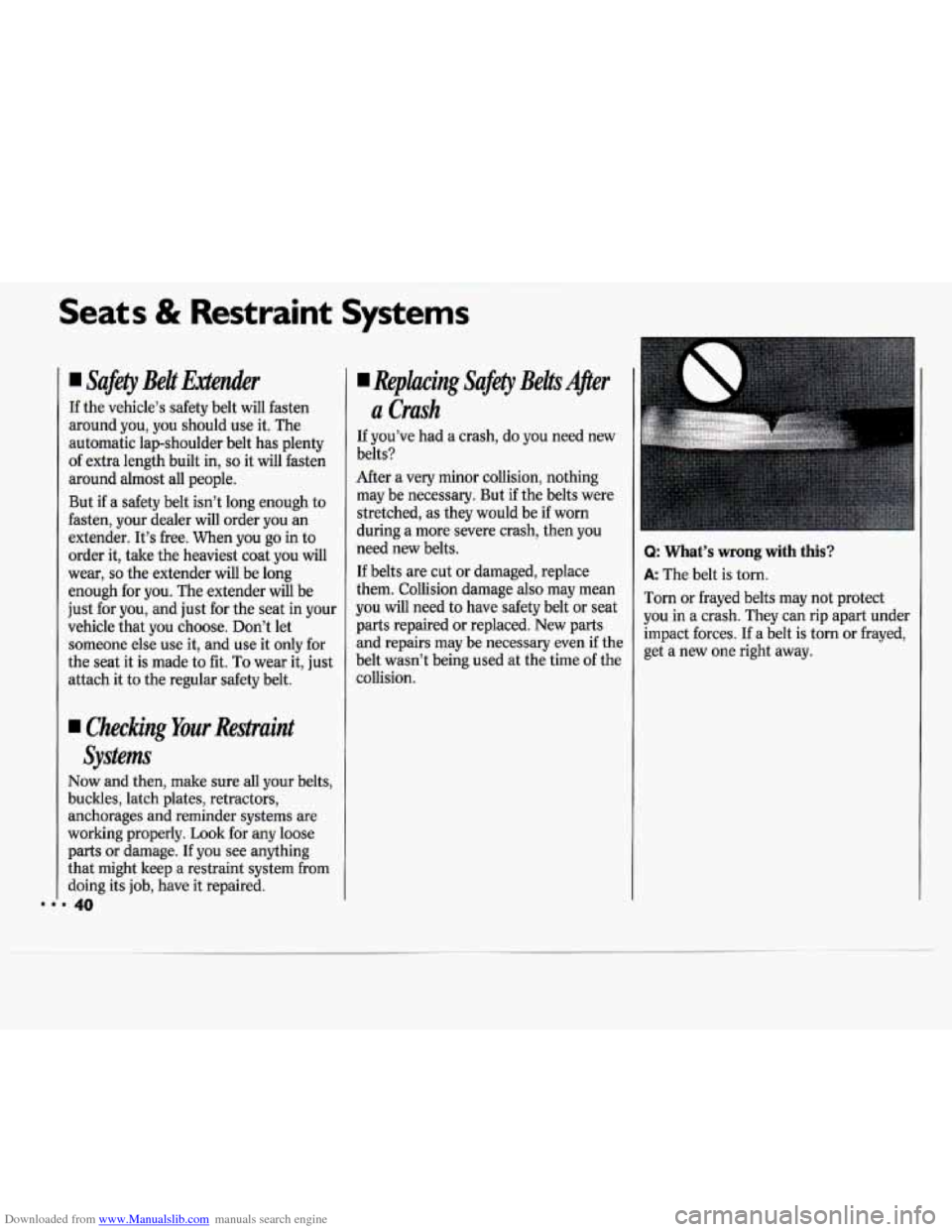
Downloaded from www.Manualslib.com manuals search engine Seats & Restraint Systems
4 Safety Belt Eaeder
If the vehicle’s safety belt will fasten
around you, you should use it. The
automatic lap-shoulder belt has plenty
of extra length built in, so it will fasten
around almost all people.
But if a safety belt isn’t long enough to
fasten, your dealer will order you
an
extender. It’s free. When you go in to
order it, take the heaviest coat you will
wear,
so the extender will be long
enough for you. The extender will be
just for you, and just for the seat in your
vehicle that you choose. Don’t let
someone else use it, and use it only for
the seat
it is made to fit. To wear it, just
attach it to the regular safety belt.
Checking Your Restraint
Systems
Now and then, make sure all your belts,
buckles, latch plates, retractors,
anchorages and reminder systems are
working properly.
Look for any loose
parts
or damage. If you see anything
that might keep a restraint system from
doing its job, have it repaired.
Replacing Safety Belts AjFer
a Crash
If you’ve had a crash, do you need new
belts?
After
a very minor collision, nothing
may be necessary. But
if the belts were
stretched, as they would be
if worn
during a more severe crash, then you
need new belts.
If belts are cut or damaged, replace
them. Collision damage
also may mean
you will need to have safety belt or seat
parts repaired or replaced. New parts
and repairs may be necessary even
if the
belt wasn’t being used at the time of the
collision.
S
Q: What’s wrong with this?
A: The belt is torn.
Torn or frayed belts may not protect
you in a crash. They can rip apart under
impact forces. If a belt is torn or frayed,
get a new one right away.
Page 87 of 243
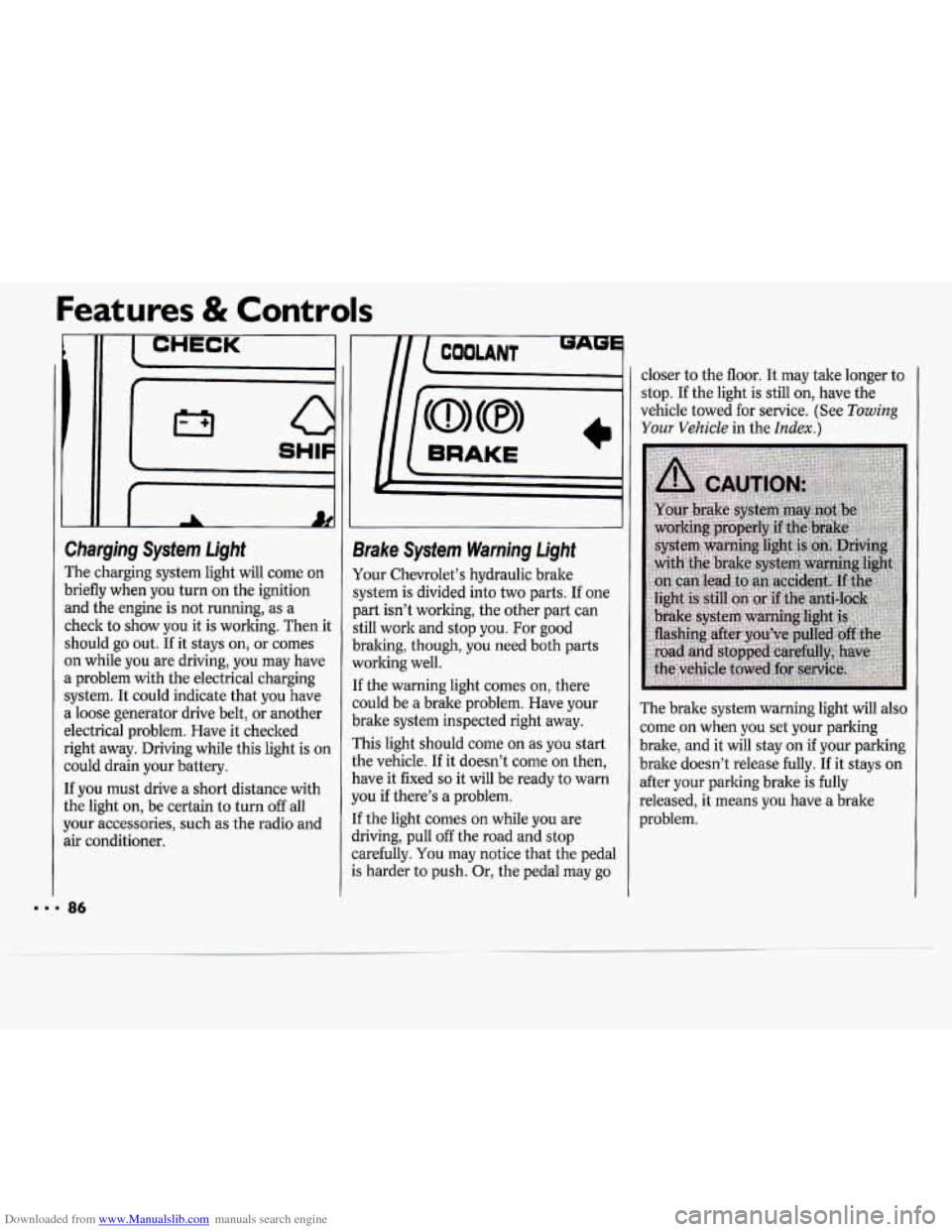
Downloaded from www.Manualslib.com manuals search engine Features & Controls
II
I CHECK
L
I
I
... 86
Charging System Light
The charging system light will come on
briefly when you turn on the ignition
and the engine is not running, as a
check to show you it is working. Then it
should
go out. If it stays on, or comes
on while you are driving, you may have
a problem with the electrical charging
system. It could indicate that you have
a loose generator drive belt, or another
electrical problem. Have it checked
right away. Driving while this light is on
could drain your battery.
If you must drive a short distance with
the light on, be certain to turn
off all
your accessories, such as the radio and
air conditioner.
m
9rake Sysfem Warning Light
tour Chevrolet’s hydraulic brake
;ystem is divided into two parts. If one
)art isn’t working, the other part can
;till work and stop you. For good
)raking, though, you need both parts
vorlting well.
[f the warning light comes on, there
zould be a brake problem. Have your
brake system inspected right away.
rhis light should come
on as you start
the vehicle.
If it doesn’t come on then,
have it fixed
so it will be ready to warn
you if there’s a problem.
[f the light comes on while you are
jriving, pull off the road and stop
zarefully.
You may notice that the pedal
.s harder to push. Or, the pedal may go closer
to the floor. It may take longer to
stop.
If the light is still on, have the
vehicle towed for service. (See
Towing
Your Vehicle in the Index.)
The brake system warning light will also
come
on when you set your parking
brake, and it will stay
on if your parking
brake doesn’t release fully. If it stays on
after your parking brake is
fully
released, it means you have a brake
problem.
Page 109 of 243
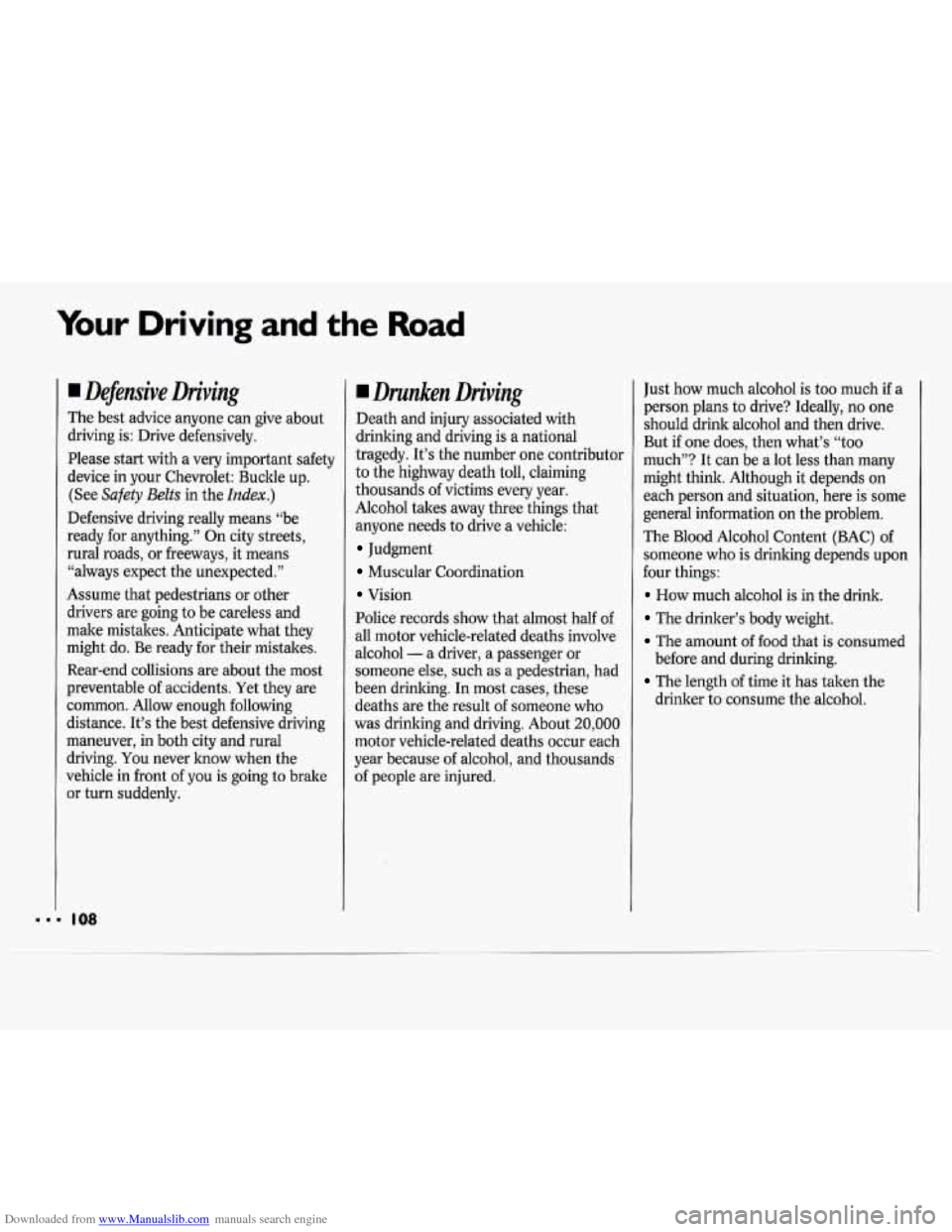
Downloaded from www.Manualslib.com manuals search engine Your Driving and the Road
Defensive Driving
The best advice anyone can give about
driving is: Drive defensively.
Please start with a very important safety
device in your Chevrolet: Buclde up.
(See
Safety Belts in the Index.)
Defensive driving really means “be
ready for anything.”
On city streets,
rural roads,
or freeways, it means
“always expect the unexpected.”
Assume that pedestrians or other
drivers are going to be careless and
make mistakes. Anticipate what they
might do.
Be ready for their mistaltes.
Rear-end collisions are about the most
preventable of accidents. Yet they are
common. Allow enough following
distance. It’s the best defensive driving
maneuver, in both city and rural
driving. You never know when the
vehicle in front of you is going
to brake
or turn suddenly.
I Drunken Driving
Death and injury associated with
drinking and driving is a national
tragedy. It’s the number one contributor
to the highway death toll, claiming
thousands of victims every year.
Alcohol takes away three things that
anyone needs to drive a vehicle:
Judgment
Muscular Coordination
Vision
Police records show that almost half of
all motor vehicle-related deaths involve
alcohol
- a driver, a passenger or
someone else, such as a pedestrian, had
been drinking. In most cases, these
deaths are the result of someone who
was drinking and driving. About
20,000
motor vehicle-related deaths occur each
year because
of alcohol, and thousands
of people are injured. Just
how much alcohol is too much if a
person plans to drive? Ideally, no one
should drink alcohol and then drive.
But
if one does, then what’s “too
much”?
It can be a lot less than many
might think. Although it depends on
each person and situation, here is some
general information on the problem.
The Blood Alcohol Content (BAC)
of
someone who is drinking depends upon
four things:
How much alcohol is in the drink.
The drinker’s body weight.
The amount of food that is consumed
before and during drinking.
The length of time it has taken the
drinker to consume the alcohol.
Page 115 of 243
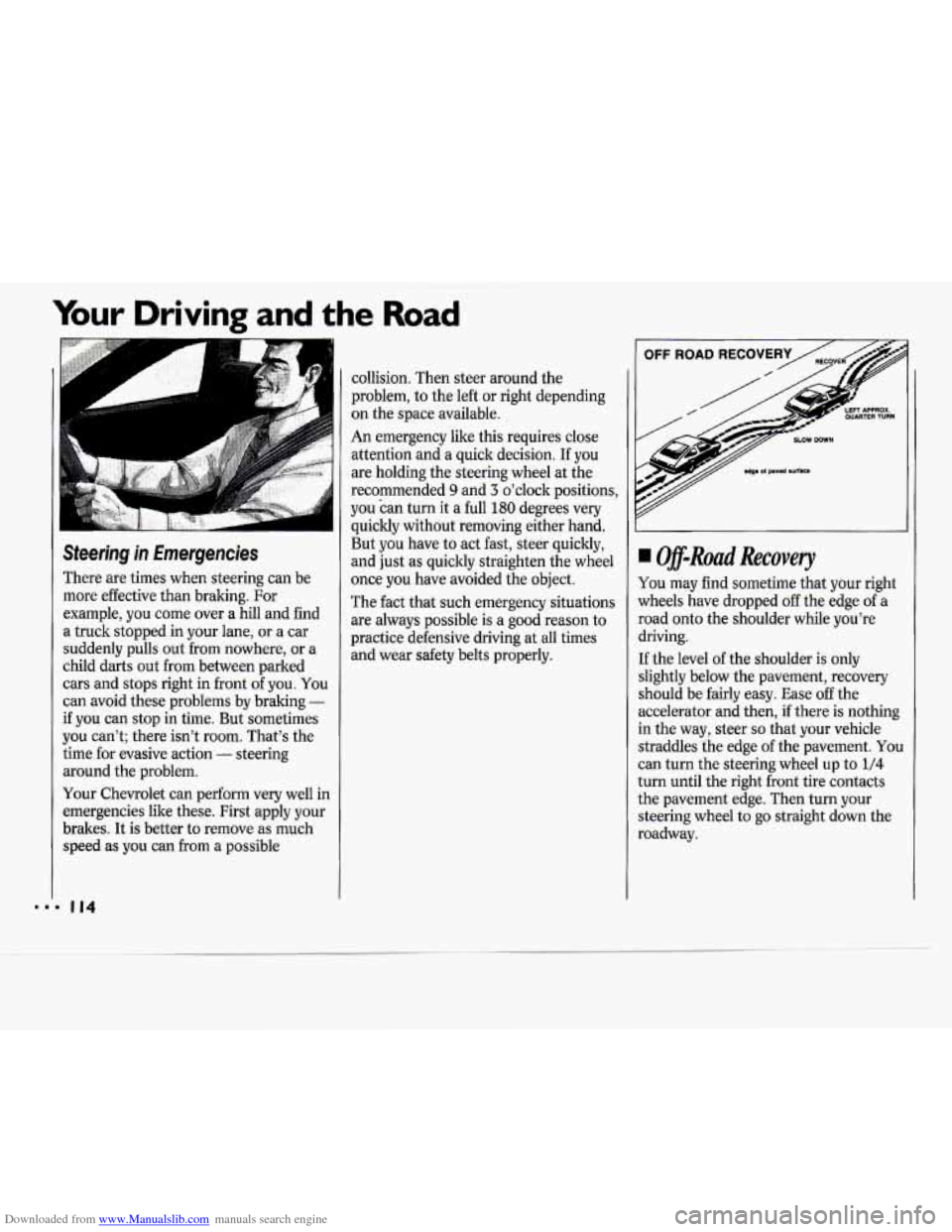
Downloaded from www.Manualslib.com manuals search engine Your Driving and the Road
P
..
Steering in Emergencies
There are times when steering can De
more effective than braking. For
example, you come over a hill and find
a truck stopped in your lane, or a car
suddenly pulls out from nowhere, or a
child darts out from between parked
cars and stops right in front
of you. You
can avoid these problems by braking -
if you can stop in time. But sometimes
you can't; there isn't room. That's the
time for evasive action
- steering
around the problem.
Your Chevrolet
can perform very well in
emergencies like these. First apply your
brakes. It
is better to remove as much
speed as you can from a possible collision.
Then steer around the
problem, to the left or right depending
on the space available.
An emergency like this requires close
attention and a quick decision.
If you
are holding the steering wheel
at the
recommended
9 and 3 o'clock positions,
you can turn it a full
180 degrees very
quickly without removing either hand.
But you have to act fast, steer quickly,
and just as quickly straighten the wheel
once you have avoided the object.
The fact that such emergency situations
are always possible is a good reason to
practice defensive driving at all times
and wear safety belts properly. I Off-Ruad Recovery
You may find sometime that your right
lvheels have dropped
off the edge of a
soad onto the shoulder while you're
hiving.
:f the level of the shoulder is only
;lightly below the pavement, recovery
;hould be fairly easy. Ease off the
iccelerator and then, if there is nothing
n the way, steer
so that your vehicle
itraddles the edge of the pavement. You
:an turn the steering wheel up to
1/4
urn until the right front tire contacts
he pavement edge. Then turn your
;teering wheel
to go straight down the
toadway.
Page 185 of 243
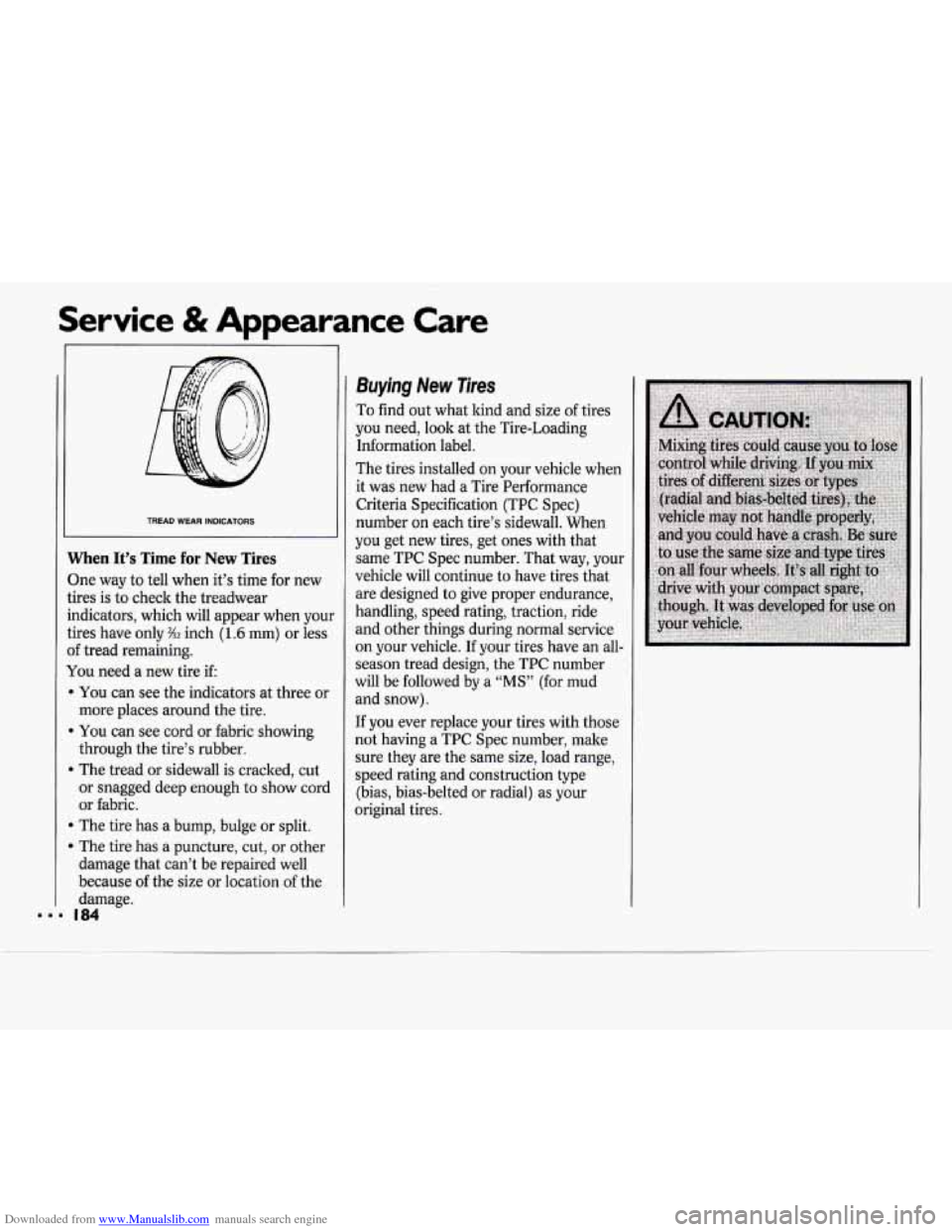
Downloaded from www.Manualslib.com manuals search engine Service & Appearance Care
TREAD WEAR INDICATORS
When It’s Time for New Tires
3ne way to tell when it’s time for new
;ires is to check the treadwear
ndicators, which will appear when your
;ires have only
%Z inch (1.6 mm) or less
If tread remaining.
llou need a new tire if:
m You can see the indicators at three or
m You can see cord or fabric showing
B The tread or sidewall is cracked, cut
more places
around the tire.
through the tire’s rubber.
or snagged deep enough
to show cord
or fabric.
B The tire has a bump, bulge or split.
The tire has a puncture, cut, or other
damage that can’t be repaired well
because of the size or location of the
damaEe.
Buying New Tires
To find out what kind and size of tires
you need,
look at the Tire-Loading
Information label.
The tires installed on your vehicle when
it was new had a Tire Performance
Criteria Specification (TPC Spec)
number on each tire’s sidewall. When
you get new tires, get ones with that
same TPC Spec number. That way, your
vehicle will continue to have tires that
are designed to give proper endurance,
handling, speed rating, traction, ride
and other things during normal service
on your vehicle. If your tires have an all-
season tread design, the TPC number
will be followed by a
“MS” (for mud
and snow).
If you ever replace your tires with those
not having a TPC Spec number, make
sure they are the same size, load range,
speed rating and construction type
(bias, bias-belted or radial) as your
original tires.
Page 191 of 243
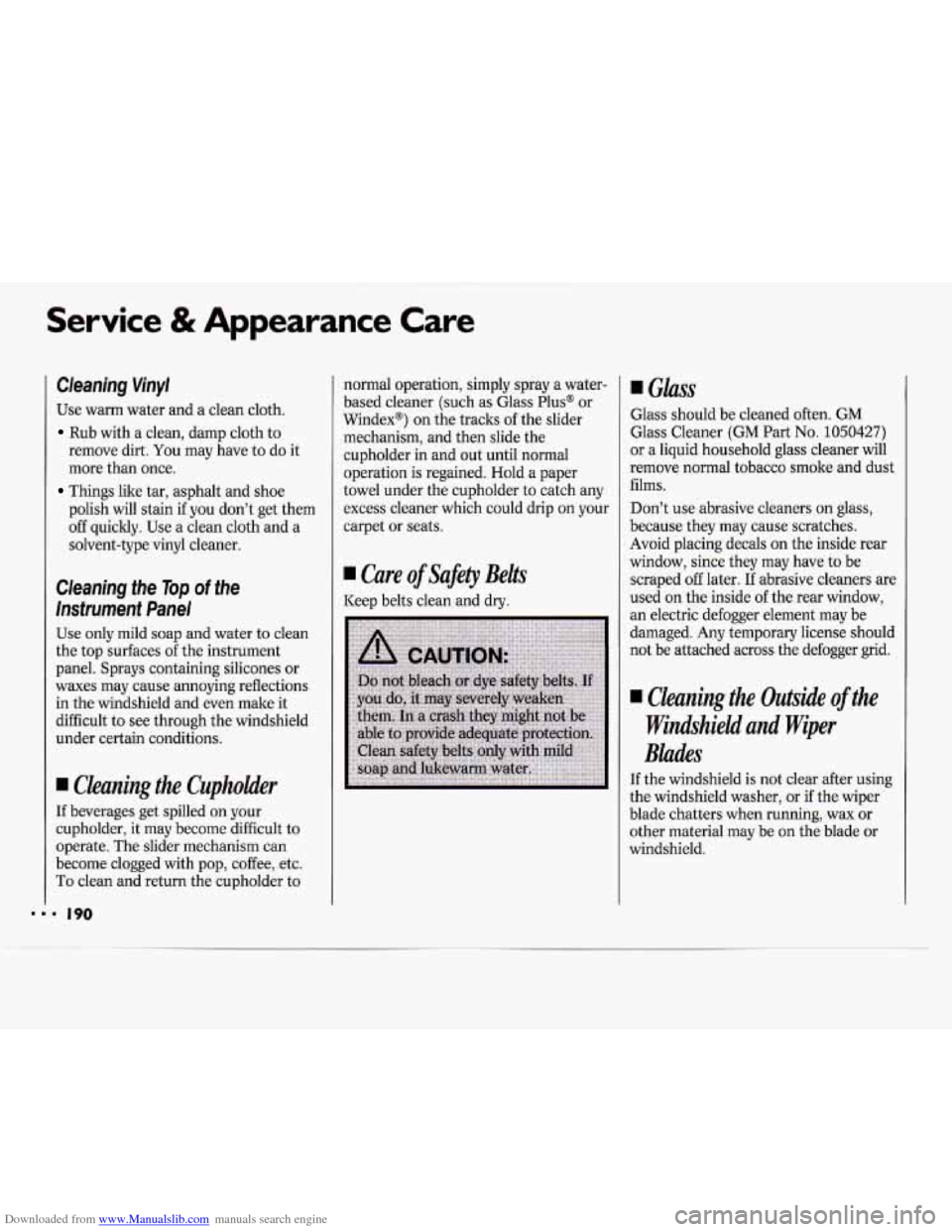
Downloaded from www.Manualslib.com manuals search engine Service & Appearance Care
190
Cleaning Vinyl
Use warm water and a clean cloth.
Rub with a clean, damp cloth to
remove dirt.
You may have to do it
more than once.
polish will stain if you don’t get them
off quickly. Use a clean cloth and a
solvent-type vinyl cleaner.
Things like tar, asphalt and shoe
Cleaning the Top of the
Instrument Panel
Use only mild soap and water to clean
the top surfaces of the instrument
panel. Sprays containing silicones or
waxes may cause annoying reflections
in the windshield and even make it
difficult to see through the windshield
under certain conditions.
1 Ckaning the Cupholder
If beverages get spilled on your
cupholder, it may become difficult to
operate. The slider mechanism can
become clogged with pop, coffee, etc.
To clean and return the cupholder to normal
operation, simply spray
a water-
based cleaner (such as Glass Plus@ or
Windex@) on the tracks of the slider
mechanism, and then slide the
cupholder in and out until normal
operation
is regained. Hold a paper
towel under the cupholder to catch any
excess cleaner which could drip on your
carpet or seats.
Care of Safety Belts
Keep belts clean and dry.
Glass
Glass should be cleaned often. GM
Glass Cleaner
(GM Part No. 1050427)
or a liquid household glass cleaner will
remove normal tobacco smoke and dust
films.
Don’t use abrasive cleaners on glass,
because they may cause scratches.
Avoid placing decals
on the inside rear
window, since they may have to be
scraped
off later. If abrasive cleaners are
used on the inside of the rear window,
an electric defogger element may be
damaged. Any temporary license should
not be attached across the defogger grid.
I Cleaning the Outside of the
Windshield and Wiper
Blades
If the windshield is not clear after using
the windshield washer, or if the wiper
blade chatters when running, wax or
other material may be on the blade
or
windshield.